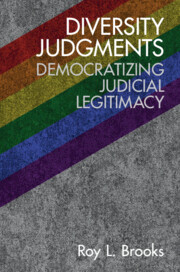Book contents
- Diversity Judgments
- Diversity Judgments
- Copyright page
- Dedication
- Contents
- Preface
- Acknowledgments
- Introduction
- Part I Asian Americans
- Part II African Americans
- Part III Women
- Part IV Latinx
- 10 Hernandez v. State of Texas (Equal Protection)
- 11 San Antonio Independent School District v. Rodriguez (School Financing)
- 12 Plyler v. Doe (Education for Undocumented Minors)
- Part V Native Americans
- Part VI LGBTQ
- Part VII Intersectionality
- Part VIII Outsiders v. Outsiders
- Part IX White Males
- Part X Situational Outsiders
- Index
10 - Hernandez v. State of Texas (Equal Protection)
from Part IV - Latinx
Published online by Cambridge University Press: 10 March 2022
- Diversity Judgments
- Diversity Judgments
- Copyright page
- Dedication
- Contents
- Preface
- Acknowledgments
- Introduction
- Part I Asian Americans
- Part II African Americans
- Part III Women
- Part IV Latinx
- 10 Hernandez v. State of Texas (Equal Protection)
- 11 San Antonio Independent School District v. Rodriguez (School Financing)
- 12 Plyler v. Doe (Education for Undocumented Minors)
- Part V Native Americans
- Part VI LGBTQ
- Part VII Intersectionality
- Part VIII Outsiders v. Outsiders
- Part IX White Males
- Part X Situational Outsiders
- Index
Summary
“Latino” or “Latinx” refers to people who come from Latin America (which excludes Spain but includes Portuguese-speaking Brazil), as opposed to “Hispanic” which refers to people of Spanish-speaking origin (including Spain but excluding Brazil whose language is Portuguese). Latinx is a geographic designation. Hispanic is a language reference. Federal policy defines “Hispanic” as an ethnicity rather than as a race. However, “for two-thirds of Hispanics, their Hispanic background is a part of their racial background – not something separate.” Same with Latinx across demographic subgroups. “For example, 69 percent of young Latinx adults ages 18 to 29 say their Latinx background is part of their racial background, as does a similar share of those in other age groups, including those 65 and older.” This suggests that both Latinx and Hispanics “have a unique view of race that doesn’t necessarily fit within the official U.S. definitions.”
- Type
- Chapter
- Information
- Diversity JudgmentsDemocratizing Judicial Legitimacy, pp. 253 - 269Publisher: Cambridge University PressPrint publication year: 2022

